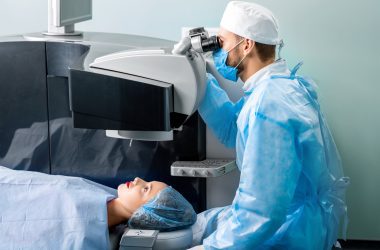Epi-LASIK Surgery
Overview
What is Epi-LASIK?
Epi-LASIK is a form of refractive surgery. This alternative to LASIK eye surgery was introduced in 2003, and has already enabled thousands of patients to go without their glasses or contact lenses. Like LASIK eye surgery, Epi-LASIK is a form of laser eye surgery for the correction of vision problems such as nearsightedness, farsightedness, and astigmatism.
Are you a candidate?

Ideal patients are adults in good overall health whose eye wear prescription has remained unchanged for at least a year prior to the surgery.
This procedure is an option for patients with certain eye conditions that make LASIK a poor choice. In particular, patients with an irregular cornea or chronic dry eyes.
Because of the way the epithelial flap is created, it works best in people with flatter corneas and mild vision problems.
The Epi-LASIK procedure
Before the surgeon begins, anesthetic eye drops will be used to numb your eyes and relieve any discomfort. You will still be able to see during the surgery, though your vision will be blurred.
The major difference between Epi-LASIK and other forms of laser eye surgery is in how the surgeon gains access to the underlying tissue of the eye.
First, the surgeon slides a plastic blade, known as an epi-keratome or epithelial separator, over the surface of the cornea gently separating the epithelial layer, or outermost layer of the eye. Gentle suction creates a hinged portion of epithelium that is then lifted out of the way exposing the underlying tissue.
Next, a laser is used to ablate (or remove) targeted corneal cells. This precise reshaping of the cornea is what corrects the patient’s vision. Then, the epithelial sheet is re-positioned over the eye where it adheres without requiring stitches. A special contact lens is then placed on the eye keeping the flap in place while it heals.
You can expect the procedure to take between one to two hours, after which you’ll be able to return home immediately.
Safety information
Epi-LASIK is considered to be among the safest forms of refractive surgery, resulting in less damage to the corneal nerves. While complications are uncommon, they can include over or under-correction of vision, halos, glare, and other vision issues. Some patients have also experienced delayed epithelial healing or loss of the epithelial flap created during the surgery.
Recovery time
The recovery time with Epi-LASIK is longer than with LASIK. Patients are typically advised not to drive for a week following the surgery. Most patients take about a week away from work and other daily routines.
During this time, it is important not to do anything that would strain or irritate the eyes. You will be given antibiotic eye drops to use after the surgery in order to promote healing and reduce the risk of infection.
The contact lens placed over the eye following surgery may be removed in a few days.
When will your vision improve?
Following surgery, many patients notice immediate improvements in their vision while others find that their vision improves gradually over several weeks or months. Full recovery time is about 3 months.
Cost of Epi-LASIK
The cost of Epi-LASIK surgery is comparable to that of other forms of laser eye surgery. The traditional Epi-LASIK procedure usually costs between $500 to $1,000 per eye, while custom Epi-LASIK using wavefront technology costs between $1,500 to $2,000 per eye.
Because it is considered an elective procedure, these costs are not usually covered by health insurance. Many doctors offer financing options for refractive surgery procedures that can make treatment more affordable.
EnhanceMyself.com relies on sources such as professional medical organizations, government agencies, academic institutions, and peer-reviewed scientific journals to write it’s articles. Learn more about how we ensure our content is accurate, in-depth, and unbiased by reading our editorial guidelines.
*Medical Disclaimer: This website does not provide medical advice. Read more.


